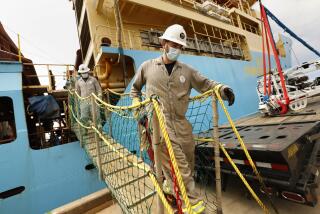Artificial Reefs Catching On in U.S. : Town Lures Fish With Underwater Junk
- Share via
WASHINGTON — When Bill Donaldson, a former mayor of Pontiac, Mich., retired to Stuart, Fla., he had no idea that he would become king of an underwater hill of junk beloved to local fishermen.
But there it is, the Bill Donaldson Reef, named after one of the leaders in artificial-reef development by residents of the southern Florida community of 9,500.
Hundreds of toilets, bathtubs, and washbowls, 75,000 concrete-weighted tires, 100 dumpsters, two school-bus bodies, a 200-foot ship, a 188-foot sand dredge and nine steel work barges--all this detritus has hit the bottom of the Atlantic Ocean to form three artificial reefs, Donaldson and two others, since the Stuart Sailfish Club and Bill Donaldson set out to improve local fishing in the 1970s.
Stuart’s residents are among hundreds of individuals and local groups all along the U.S. coasts who are sinking both dollars and debris into improving fish habitat. They’re putting all kinds of discarded objects on ocean floors to create reefs for fish where nature neglected to put them.
Ninety percent of the ocean floor around the United States is a sand and mud wasteland with little plant growth. The artificial reefs provide growing surfaces for plants and animals that fish eat.
A properly constructed artificial reef increases an area’s fish population over time. In theory, it initially drains neighboring natural reefs of some fish, but it also provides new shelter from predators and new food that reduces competition on the natural reefs. Within two years, both the natural and artificial reefs become crowded with fish.
What sounds good in theory looks good in practice, according to studies conducted by the National Marine Fisheries Service, a federal agency. A 1971-74 test at Murrell’s Inlet, S.C., for example, showed that catches over a tire-and-vessel artificial reef equaled those over nearby natural rock reefs.
Impressive test results at sea don’t always please on-shore environmentalists. But Richard Stone of the Fisheries Service says he has received very little criticism since he began developing artificial reefs in the 1960s.
“People don’t object to enhancing areas if they can be shown that it’s not going to be detrimental to something that’s already there,” Stone says. “What they would object to is to just dispose of material--ocean dumping under the guise of ocean reefs--or if they thought you were pitching things off that did have some toxic by-products or putting something down on existing live-bottom areas or coral reefs.”
Just about anything that can be sunk will help build a reef, Stone says, but some materials are more durable than others. Thin metal objects such as car bodies and refrigerators deteriorate rapidly and move around too much if they are not weighted properly. But many other metal scraps, including cleaned-out ships and collapsed oil rigs, have made successful reefs, he says.
The most effective fish condominiums according to a test conducted by a marine consulting firm, are fiberglass-reinforced plastic units. These units can be adjusted to fit various ocean-bottom terrains and to reach different heights depending on the type of fish desired. Some highly sought fish often are found on taller structures.
The durable plastic units can be transported more easily than old ships or weighted tires. Unfortunately, they are now available only from Japanese manufacturers in very limited quantities.
The Japanese, world leaders in reef development, have used these units successfully for seven years. The Japanese reef program, unlike the grass-roots efforts in the United States, is centrally planned and subsidized.
In the United States the majority of reefs are for recreational fishing, but in Japan reef development is carried out by and for commercial fishermen. Another difference between the two countries’ policies is legal--here the ocean is open to any U.S. fisherman, but Japan recognizes ocean ownership rights, and the builder of a reef there holds the exclusive rights to fish it.
Stone says he doubts that U.S. government participation will ever equal that of the Japanese government, but he hopes that state governments will become more involved.
More to Read
Sign up for Essential California
The most important California stories and recommendations in your inbox every morning.
You may occasionally receive promotional content from the Los Angeles Times.










